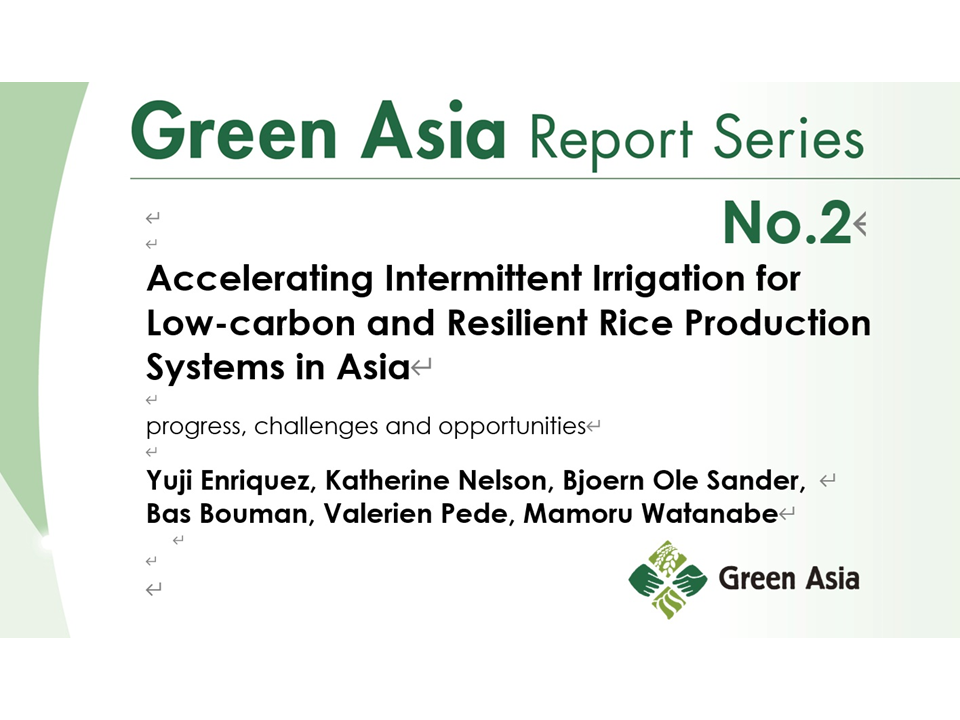Pick Up
1064. Green Asia Report Series No. 2 : Accelerating intermittent irrigation for low-carbon and resilient rice production systems in Asia

1064. Green Asia Report Series No. 2 : Accelerating intermittent irrigation for low-carbon and resilient rice production systems in Asia
The second issue of the Green Asia Report Series, " Accelerating intermittent irrigation for low-carbon and resilient rice production systems in Asia: Progress, Challenges, and Opportunities," has been published. This series aims to introduce scalable technologies that can be shared in the Asia-Monsoon region and contribute to the transformation of food systems in the region, by serving as a reference for various stakeholders, including government officials, researchers, extension officers, producers, and the private sector. The second issue introduces intermittent irrigation technology, which is expected to have effects such as water saving, greenhouse gas (GHG) emission reduction, and yield stabilization in rice cultivation.
Water management plays a crucial role in adapting rice cultivation to climate risks while reducing GHG emissions from rice cultivation. This is because irrigated rice cultivation in lowlands is susceptible to drought and rice cultivation in irrigated areas has historically been carried out by flooding, which creates anaerobic conditions and promotes CH4 emissions from methanogens that thrive in flooded soils. Reducing the duration and condition of flooding can reduce the amount of irrigation water used and significantly suppress the production and emission of CH4 by methanogens. Intermittent irrigation technology is one method of achieving efficient water management.
Intermittent irrigation technologies have multiple patterns and names, but they all follow a common principle. They can be broadly divided into those that drain water only once to create a state in which air is introduced into the soil only once (aeration) and those that drain water multiple times. The former drains water or aerates only once, like midseason drainage, while the latter drains water or aerates multiple times. The latter include AWD (Alternate Wetting and Drying) and MiDi (Midseason Drainage followed by Intermittent Irrigation). This report compares the background, history, and methods of these technologies. It also analyzes the current state and challenges of AWD, a representative intermittent irrigation technology, and introduces examples of efforts for the technology in the Philippines and Vietnam. It also presents measures to spread and develop intermittent irrigation technologies in Asia in the future.
Report Series https://www.jircas.go.jp/en/greenasia/report
International Center for Strategy "MIDORI" https://www.jircas.go.jp/en/greenasia
Accelerating intermittent irrigation for low-carbon and resilient rice production systems in Asia: Progress, challenges and opportunities https://doi.org/10.34556/gars-e.2
※ AWD (Alternate Wetting and Drying): From two weeks after transplanting, water is drained and re-flooded intermittently, except for one week before and after flowering. To avoid yield loss, users are recommended to monitor and re-flood the paddy field before the water level drops to 15 cm below the soil surface.
※ MiDi (Midseason Drainage followed by Intermittent Irrigation): Mid-season drainage is continued for a certain period of time, followed by repeated flooding and draining at short intervals. The timing and duration of flooding are determined by the growth stage, and intermittent irrigation is carried out after draining for 1-2 weeks between the late tillering and panicle formation stages.
Contributor: WATANABE Mamoru (Rural Development Division)
